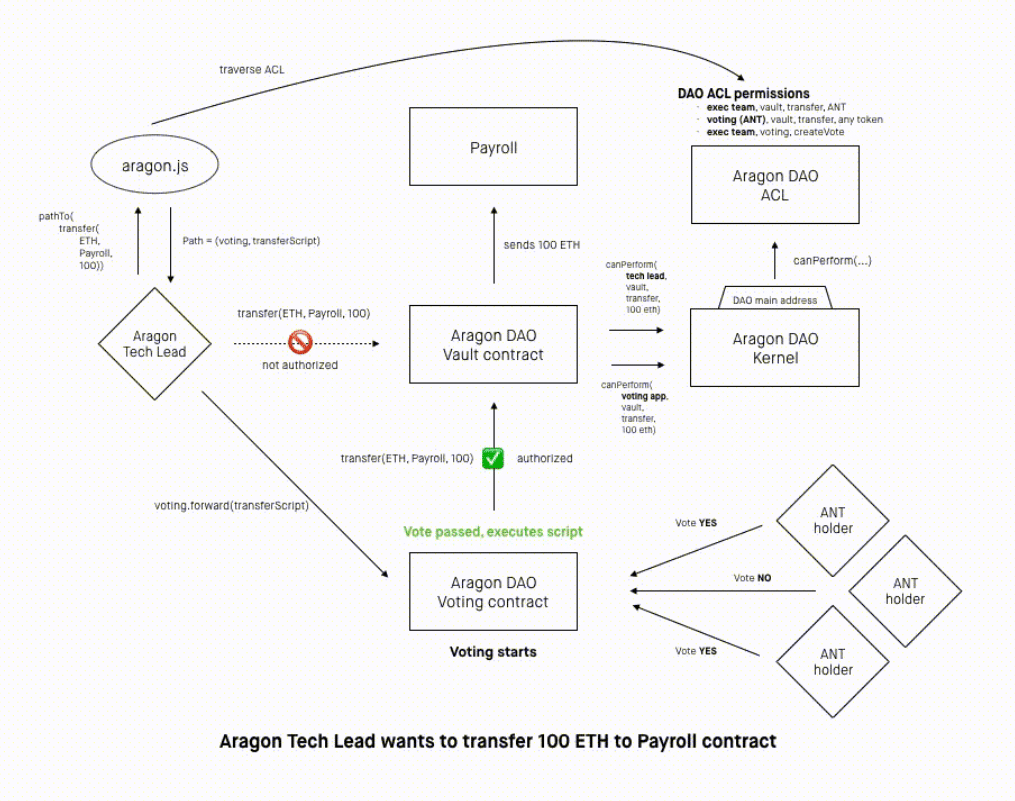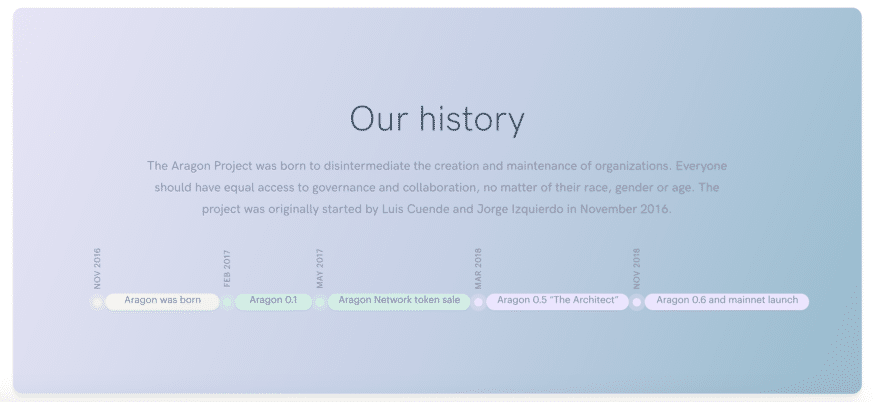Latest news about Bitcoin and all cryptocurrencies. Your daily crypto news habit.
What Is Aragon?
Aragon is a decentralized app (dApp) on the Ethereum blockchain that allows anyone to create and manage a decentralized organization. The project is open source and led by the Aragon Foundation. It also includes a token, ANT, that grants voting rights to make decisions about the direction of future development. Eventually, the team hopes the project to be a fully decentralized autonomous organization and dApp that’s a neutral jurisdiction for anyone to create an organization on the blockchain.
Traditional organizations have a significant budget for overhead and administrative functions. In addition, when they transact with other organizations, fees, delays, and middlemen can pile up. This increases friction on the overall economy. Aragon’s vision is removing that friction with decentralized organizations that operate on a shared platform.
Nearly all organizations have a few core administrative functions in common. They need to provide equity to investors, allow shareholders to vote on governance decisions, raise money, pay employees and contractors, and implement access control for accounting and risk purposes. These functionalities come standard (see “Out of the Box Functionality” below) as part of the Aragon dApp for any new organization built on the network.
The team’s vision is to make it simple and easy to set up and operate an organization on the blockchain. Using open source tools and the security of the Ethereum blockchain, the project is aimed at growing corporate adoption of blockchain technology for practical uses. In this article, we’ll explore how it works through the following areas and you’ll be able to decide for yourself if Aragon is a game changer for blockchain adoption.
- Blockchain Barriers to Entry
- Out of the Box Functionality
- Modular Custom Features
- Digital Jurisdiction
- Aragon One
- Team
- Roadmap
- ANT Token
- How to Buy Aragon Token (ANT)
- How to Store Aragon Token (ANT)
- Conclusion
- Additional Resources
Blockchain Barriers to Entry
A lot of companies are interested in testing out blockchain solutions for stakeholders, payments, and governance. However, there are several hurdles that make it difficult for companies to take the first step.
The biggest of these hurdles is a lack of expertise. Most companies don’t have blockchain experts on staff. Consequently, they don’t know where to start with smart contract development, dApps, and decentralized organization.

Aragon’s features allow you to meet your specific needs
There are also bigger problems that are inherent to blockchain that make organizations nervous. The idea of an immutable ledger is powerful, but it’s also frightening when mistakes can’t be quickly corrected. In the case of smart contract development, there is always a probability of bugs introduced into the code. As such, software needs to be easily upgradable, and there should be a bug bounty mechanism in place to incentivize finding and fixing bugs. Aragon is working on these solutions.
In addition, Aragon is addressing subjectivity in smart contract breaches. With every smart contract, you can encode many of the possible breaches of contract. However, there are also more subjective cases, especially in complex relationships. Aragon establishes an arbitration system for conflicts that aren’t explicitly addressed in the smart contract code.
Out of the Box Functionality
Out of the box, Aragon offers several core features. It has a module for identity management and closely related modules for ownership and access control. Other modules include shareholder voting, fundraising through token generation, HR onboarding and payroll, and accounts payable/receivable. Taken together, the core functionality of Aragon covers the critical aspects of accounting, governance, and identity that make modern companies work.
As you can see, these modules make up most of the administrative functions that a modern company or organization requires. It’s important to emphasize that these modules can individually be turned on and off, providing instant customization for the company’s needs. In addition, all of the code behind Aragon is open source. A company’s development team could edit them as needed to fulfill the company’s requirements.
Modular Custom Features
The modular design of Aragon doesn’t stop with the core modules that come standard. Just as companies can edit existing modules, they’re free to develop completely new models as well. They can also develop atop the data and structures of existing models for extended functionality.
The Aragon Foundation envisions the Core software could also find uses outside of operating traditional businesses. It’s possible entirely different use cases could emerge:
- Election voting and national polls: Smart contracts could facilitate a prediction model that checks if elected officials stick to their campaign promises and reward their supporters when they do.
- Contractor payment: Onboard individuals or even other companies as subcontractors and pay them on an independent basis.
- Enhanced analytics and accounting: Add data visualization and layers of analysis on top of the accounting, identity, and voting information that your organization generates.
The modular nature of Aragon, combined with its open source ethos, means we could see a whole ecosystem of free to use modules that extend capacity for organizations on the platform.
Digital Jurisdiction
Aragon explicitly has the goal of creating a digital jurisdiction. Just like countries have jurisdiction over their citizens when it comes to courts of law, Aragon wants to create the first digital court of law. This court wouldn’t operate based on country boundaries. Instead, it would help enforce digital contracts between organizations on the Aragon platform.
Aragon One
In the early days of development, the project relied on the nonprofit Aragon Foundation to provide direction and support as the project got off the ground. Aragon One was the first step in the decentralization of the project, replacing the Foundation. It encompasses the team from the Aragon Foundation, including Aragon One CEO, and former project lead, Luis Cuende. In the future, the platform will be entirely decentralized and community led. Holders of the ANT token will have voting rights on all issues concerning the project.
Team
Aragon is an open source, non-profit project. It has many contributors. It also doesn’t technically have a CEO or CTO. Instead, it began with a project lead. However, following the decentralization goals of the project, the project lead stepped down upon the creation of Aragon One.
Luis Cuende was leading the project. In 2011, he received a “Best Underage European Programmer” award, and he’s a recipient of Forbes’ 30 under 30 recognition. He’s a young guy, but with leadership and technical chops. He has advised the Vice President of the European Commission and is an MIT Innovators Under 35 awardee. He has founded several startups and created the first Linux distribution with face login.
The ultimate goal of the project, however, is for Aragon to no longer need a team. The developers hope community involvement and support will drive future initiatives and the Foundation will only play a minor role in coordinating contributions.
Roadmap
Aragon has been busy in 2018, releasing Aragon 0.1, 0.5, and most recently, on October 30, 2018, Aragon 0.6, which allows you to create organizations on Ethereum’s Mainnet. From the team’s blog post about the 0.6 launch this means, “Today, decentralized organizations get real.” Since the initial launch, over 15,000 organizations have been created using the platform.
The project’s next steps are towards further decentralization and eventual complete running of the platform by the community.
ANT Token
As mentioned previously, the ANT token represents a share of governance on Aragon. It grants voting rights on development proposals. The amount of ANT you own determines the strength of your voting power.
Trading History
The ANT token launched with an ICO in May 2017. At the time, it was among the most successful ICOs ever. It raised $24 million in fifteen minutes.
The price of ANT hasn’t seen the massive growth that we’ve seen in other cryptocurrencies. Since its launch, ANT has flown under the radar. It’s currently among the top 200 cryptos by market cap.
ANT peaked with the rest of the crypto market in January 2018 at $7.73, but hit another high point more recently in May 2018 at $4.88 as well. It’s unclear what may have caused the April-May rise in price. After this ANT’s value continued to decline, leveling off over the past couple months around $0.75, a significant drop even from its ICO price.
Surprisingly, the launch of the Aragon mainnet had little to no effect on the price. This lack of movement may be a sign that the days of speculative investing are over for the crypto community. Moving forward, the only thing that might positively affect the price is simply adoption.
How to Buy Aragon Token (ANT)
ANT is available on many major cryptocurrency exchanges. However, there is no direct fiat gateway to buy ANT. If you’d like to purchase ANT, you’ll need to first but BTC or ETH, as those are the most popular trading pairs for ANT.
You can find ANT on Bittrex, Liqui, HitBTC, EtherDelta, and IDEX, among others.
How to Store Aragon Token (ANT)
Since Aragon is a dApp built on the Ethereum blockchain, the ANT token is an ERC-20 compatible token.
As such, you can store ANT using any Ethereum compatible wallet. MyEtherWallet paper wallets are a popular option for easy and secure storage. For the highest level of security, consider a hardware wallet like Trezor or the Ledger Nano S.
If your wallet has difficulty recognizing the ANT tokens once you’ve transferred them, check out EtherScan to get the contract address and decimals to point your wallet in the right direction.
Conclusion
Making it easy to create and manage organizations on the blockchain is an important step for blockchain usability. Aragon has taken steps forward in its mission to get many organizations on its platform and the network effects for transactions and efficiency between organizations could be enormous. We will have to wait and see if full decentralization is achieved, and what the results of the Aragon 0.6 launch will be.
Editor’s Note: This article was updated by Rachel Lantz on November 3, 2018, to reflect the recent changes of the project.
Additional Resources
Disclaimer
The views and opinions expressed in this article are solely those of the authors and do not reflect the views of Bitcoin Insider. Every investment and trading move involves risk - this is especially true for cryptocurrencies given their volatility. We strongly advise our readers to conduct their own research when making a decision.


